Applied Corporate Strategy: Uber's Acquisition of Postmates Analysis
VerifiedAdded on 2022/12/22
|16
|3863
|66
Report
AI Summary
This report provides a comprehensive strategic analysis of Uber, focusing on its acquisition of Postmates. It begins with an introduction to Uber and the ride-hailing industry, followed by an external analysis using PESTLE and Porter's Five Forces frameworks to identify opportunities and threats within the transportation sector. The PESTLE analysis examines political, economic, social, technological, and environmental factors impacting Uber, while Porter's Five Forces assesses the competitive landscape. The report then delves into an internal analysis, evaluating Uber's resources and competencies. It identifies key resources, such as valuable market position, innovation, and a well-established network, as well as weaknesses like low profitability. The report then uses value chain and VRIO analyses to identify a core competence. The analysis considers both the internal strengths and weaknesses of Uber and the external opportunities and threats derived from the market analysis. The report helps to understand Uber's strategic position and potential for future growth.
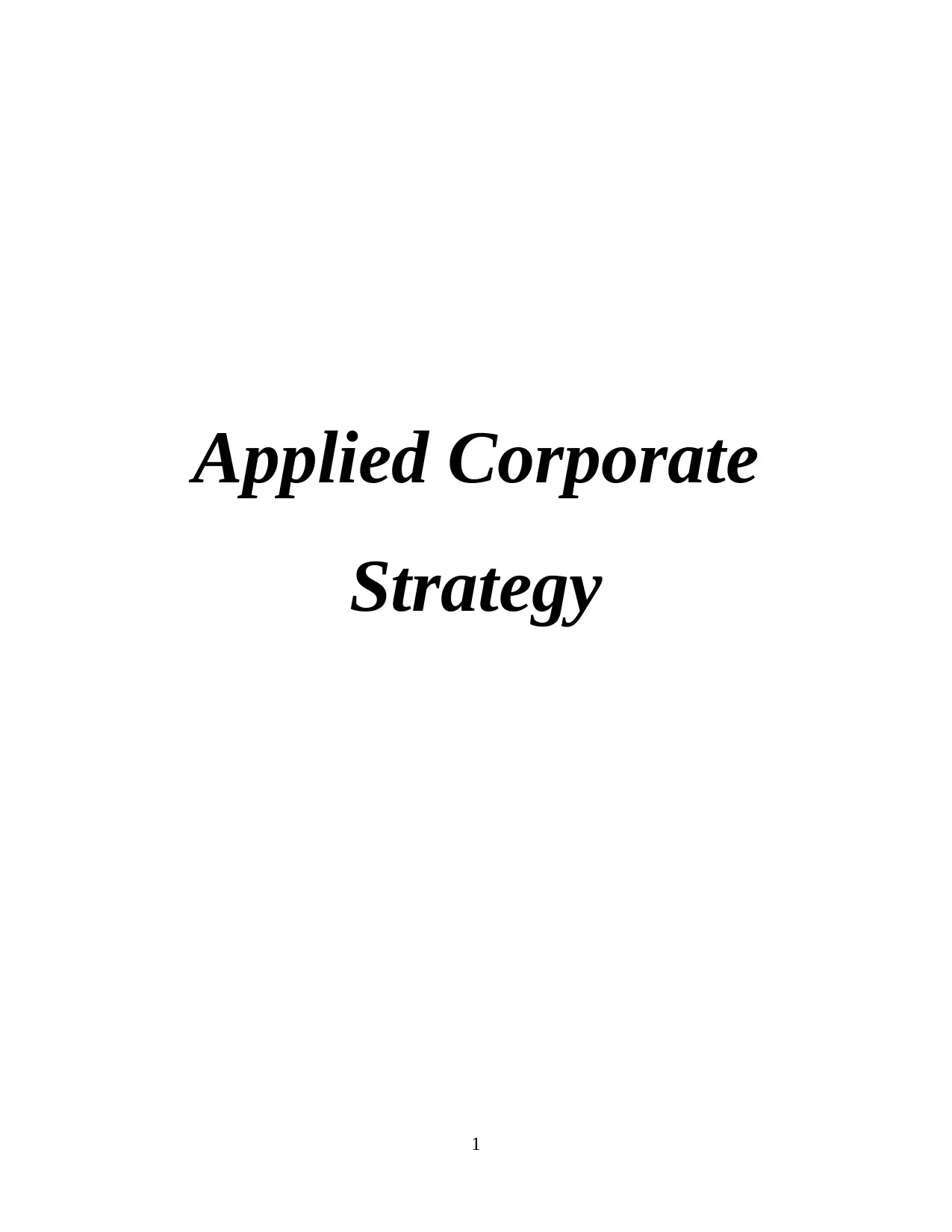
Applied Corporate
Strategy
1
Strategy
1
Paraphrase This Document
Need a fresh take? Get an instant paraphrase of this document with our AI Paraphraser
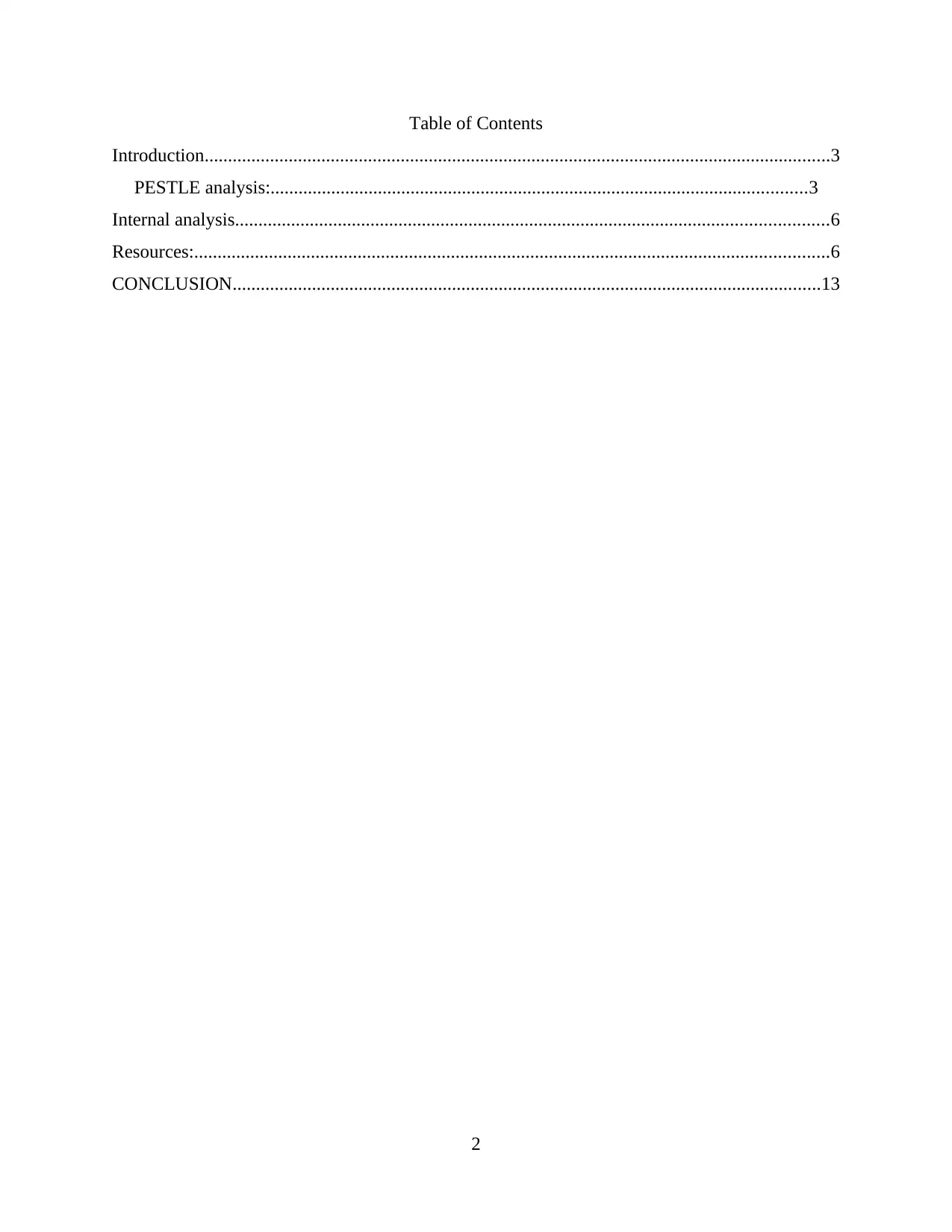
Table of Contents
Introduction......................................................................................................................................3
PESTLE analysis:...................................................................................................................3
Internal analysis...............................................................................................................................6
Resources:........................................................................................................................................6
CONCLUSION..............................................................................................................................13
2
Introduction......................................................................................................................................3
PESTLE analysis:...................................................................................................................3
Internal analysis...............................................................................................................................6
Resources:........................................................................................................................................6
CONCLUSION..............................................................................................................................13
2

Introduction
The external environment is never constant it is changing very fast is highly dynamic. Such
constant changes are offering large number of threat and opportunities for organisations. Further
there is need to maximize the opportunities and make attempts to minimize threats in order to
manage its overall impact on the organisation productivity. Presently there is analysis of Uber
that is a ride hailing vehicle having its operations across 900 metropolitan areas across world. It
is having approx 93 million active users across world. Presently the report is based on the
analysis of the corporate strategy of Uber to buy postmates for 2.65 billion dollars. For this
purpose there is need to make analysis of the external and internal environment of Uber (Nayak.
and Kayarkatte, 2020). There is application of PESTLE & Porters five forces to make an external
environment evaluation. For internal analysis there is use of VRIO analysis in order to justify the
most appropriate strategy selection.
PESTLE analysis:
It is an external environmental framework that is used for making a detailed analysis of the
issues that are leading to generation of opportunity or threat in terms of transportation industry:
Political factors: According to statistics published by statistic research department in year 2021,
in March 2021, approx 58 percent of the British people are having an approach that third biggest
issue in UK has been willing to leave European Union that was according to 39 percent of
British adult. It is a threat as there will be a complete change in the regulations and legal
policies that will be affecting functioning of various industries. The EU UK trade cooperative
agreement is applicable since 1 January 2021.
Economic factors: the COVID 19 situation has lead to generation of economic issues such as
GDP of UK is projected by 5 percent below the required fourth quarter in year 2019. The fiscal
efforts have also been reduced because of the emergency measures because of this pandemic
situation. So there is a major issue of low projection growth that is a threat for organisations.
Another issue is reduction in customer purchasing power. The consumer spending and low
energy prices have declined which is imposing a big threat for business expansion opportunities.
But this leads to generation of opportunity in terms of using some other business segment to be
approached (UNITED KINGDOM: ECONOMIC AND POLITICAL OUTLINE, 2020)
3
The external environment is never constant it is changing very fast is highly dynamic. Such
constant changes are offering large number of threat and opportunities for organisations. Further
there is need to maximize the opportunities and make attempts to minimize threats in order to
manage its overall impact on the organisation productivity. Presently there is analysis of Uber
that is a ride hailing vehicle having its operations across 900 metropolitan areas across world. It
is having approx 93 million active users across world. Presently the report is based on the
analysis of the corporate strategy of Uber to buy postmates for 2.65 billion dollars. For this
purpose there is need to make analysis of the external and internal environment of Uber (Nayak.
and Kayarkatte, 2020). There is application of PESTLE & Porters five forces to make an external
environment evaluation. For internal analysis there is use of VRIO analysis in order to justify the
most appropriate strategy selection.
PESTLE analysis:
It is an external environmental framework that is used for making a detailed analysis of the
issues that are leading to generation of opportunity or threat in terms of transportation industry:
Political factors: According to statistics published by statistic research department in year 2021,
in March 2021, approx 58 percent of the British people are having an approach that third biggest
issue in UK has been willing to leave European Union that was according to 39 percent of
British adult. It is a threat as there will be a complete change in the regulations and legal
policies that will be affecting functioning of various industries. The EU UK trade cooperative
agreement is applicable since 1 January 2021.
Economic factors: the COVID 19 situation has lead to generation of economic issues such as
GDP of UK is projected by 5 percent below the required fourth quarter in year 2019. The fiscal
efforts have also been reduced because of the emergency measures because of this pandemic
situation. So there is a major issue of low projection growth that is a threat for organisations.
Another issue is reduction in customer purchasing power. The consumer spending and low
energy prices have declined which is imposing a big threat for business expansion opportunities.
But this leads to generation of opportunity in terms of using some other business segment to be
approached (UNITED KINGDOM: ECONOMIC AND POLITICAL OUTLINE, 2020)
3
⊘ This is a preview!⊘
Do you want full access?
Subscribe today to unlock all pages.

Trusted by 1+ million students worldwide

Social factors: COVID 19 has been one of the top issues that are faced across different parts of
the world in present scenario. It has lead to a shift in the overall preferences of people as there is
more risk of spreading of virus from public transports and vehicles. So, this issue is leading to
generation of threats for the public transport industry. Apart from this issue has been itself a
threat for many industries such as retail industry, automobile industry (Hales and Mclarney,
2017). It focussed to generation of opportunity as the existing business organisations’ to merge
or acquire any other different business segment that can easily be comply and supplement the
present business operation and functions. It is going to help in enhancing the present market
share by offering of low cost options to the present loyal customer base.
Technological factors: There has been a new technological advancement where there is focus on
use of drone deliveries as technological advancement. It is an issue requiring high amount of
investment and a complete transformation but is an opportunity to manage workforce
requirements in organisations. It is more capital intensive approach that can be used by
organisations as compared to labour intensive approach.
Environment factor: United Kingdom is having considerable amount of mineral resources. It is
10the largest producer of oil across world has they are having huge natural gas reserves. But the
industrial sector that is contributing to 17.4 percent to GDP and 18 percent to working population
is not that competitive. There has been a shift towards more sustainable approaches in form of
eco friendly packaging and use of recyclable products. So this issue is leading to an opportunity
for organisations to modify or expand their approaches to a more sustainable measure. Now the
present business scenario is to use more sustainable approaches that can help in making
significant contribution to the environment and society.
From above discussed PESTLE analysis there are various business issues that is creating
both threats and business opportunities. According to other framework analysis a particular
opportunity can be selected to expand the present business share and deal with the negative
impact from such threats.
Porters five forces:
Porter’s five forces is a basic framework that is used to make a competitive analysis of the
industry to which a particular organization is part of. There is associated threat with each factor
that might by low, high or moderate depending upon the situations in macro environment. In
present scenario there is analysis of the five forces elements for Transportation industry:
4
the world in present scenario. It has lead to a shift in the overall preferences of people as there is
more risk of spreading of virus from public transports and vehicles. So, this issue is leading to
generation of threats for the public transport industry. Apart from this issue has been itself a
threat for many industries such as retail industry, automobile industry (Hales and Mclarney,
2017). It focussed to generation of opportunity as the existing business organisations’ to merge
or acquire any other different business segment that can easily be comply and supplement the
present business operation and functions. It is going to help in enhancing the present market
share by offering of low cost options to the present loyal customer base.
Technological factors: There has been a new technological advancement where there is focus on
use of drone deliveries as technological advancement. It is an issue requiring high amount of
investment and a complete transformation but is an opportunity to manage workforce
requirements in organisations. It is more capital intensive approach that can be used by
organisations as compared to labour intensive approach.
Environment factor: United Kingdom is having considerable amount of mineral resources. It is
10the largest producer of oil across world has they are having huge natural gas reserves. But the
industrial sector that is contributing to 17.4 percent to GDP and 18 percent to working population
is not that competitive. There has been a shift towards more sustainable approaches in form of
eco friendly packaging and use of recyclable products. So this issue is leading to an opportunity
for organisations to modify or expand their approaches to a more sustainable measure. Now the
present business scenario is to use more sustainable approaches that can help in making
significant contribution to the environment and society.
From above discussed PESTLE analysis there are various business issues that is creating
both threats and business opportunities. According to other framework analysis a particular
opportunity can be selected to expand the present business share and deal with the negative
impact from such threats.
Porters five forces:
Porter’s five forces is a basic framework that is used to make a competitive analysis of the
industry to which a particular organization is part of. There is associated threat with each factor
that might by low, high or moderate depending upon the situations in macro environment. In
present scenario there is analysis of the five forces elements for Transportation industry:
4
Paraphrase This Document
Need a fresh take? Get an instant paraphrase of this document with our AI Paraphraser

Threat of new entrants (Moderate): This threat is moderate for existing organisations’. But there
overall measures that the public transportation industry is a labour intensive industry. There is les
requirement of updated skills as compared to other sectors such as IT. So, unemployment rate is
expected to rise in tear 2021 that is predicted to be 7.4 percent as compared to earlier rise that
was 6.1 percent. So it is going to lead towards cheap availability of workforce that may lead to
new start-ups willing to enter the public transportation industry.
Threat of substitution (High): It is aspect that is related with the replacement of a particularly
brand with another (Aithal, 2017). Customer posses zero switching cost in case of public
transportation industry there are availability of large number of options for customers. So it can
be summarized that there is high threat of substitution.
Suppliers bargaining power (High): supplier barraging power in case of public transpiration
industry is significantly high because it is subject to partners and drivers who are holding rides.
Generally the brands are utilizing an outsourcing strategy for assets and work according to its
terms & conditions are based on a web based application. Generally the drivers are offered an
opportunity to select between a particular association and its rivals. It may lead to additional
organizational expenses by offering some attractive perks, allowance or compensation in order to
get competent workforce. So this factor posses a high barging power in the public transportation
industry.
Customers bargaining power (High): The customer bargaining power is related with the aspect
whether they are able to switch easily from one company to another and the associated switching
cost. When the products or services are both having much differentiation then in this cases the
competition is all about process. In the public transportation industry there is high barging power
of customers as they demand services with better quality and low process. So, being part of
undifferentiated industry it becomes important to catch the customer attention with managing of
margins and enhancing present base.
Competitive rivalry (Moderate): In relation to transportation industry there are limited numbers
of competitors in the public transit. Various private mobility service providers have disrupted the
industry buy offering of internet style digital transport services. It includes companies like Didi
chuxing, Uber, Mobile, car sharing vehicle like ZipCar. There are also challenges related with
navigation of governmental policies to deal with all legal implications. So, overall competitive
5
overall measures that the public transportation industry is a labour intensive industry. There is les
requirement of updated skills as compared to other sectors such as IT. So, unemployment rate is
expected to rise in tear 2021 that is predicted to be 7.4 percent as compared to earlier rise that
was 6.1 percent. So it is going to lead towards cheap availability of workforce that may lead to
new start-ups willing to enter the public transportation industry.
Threat of substitution (High): It is aspect that is related with the replacement of a particularly
brand with another (Aithal, 2017). Customer posses zero switching cost in case of public
transportation industry there are availability of large number of options for customers. So it can
be summarized that there is high threat of substitution.
Suppliers bargaining power (High): supplier barraging power in case of public transpiration
industry is significantly high because it is subject to partners and drivers who are holding rides.
Generally the brands are utilizing an outsourcing strategy for assets and work according to its
terms & conditions are based on a web based application. Generally the drivers are offered an
opportunity to select between a particular association and its rivals. It may lead to additional
organizational expenses by offering some attractive perks, allowance or compensation in order to
get competent workforce. So this factor posses a high barging power in the public transportation
industry.
Customers bargaining power (High): The customer bargaining power is related with the aspect
whether they are able to switch easily from one company to another and the associated switching
cost. When the products or services are both having much differentiation then in this cases the
competition is all about process. In the public transportation industry there is high barging power
of customers as they demand services with better quality and low process. So, being part of
undifferentiated industry it becomes important to catch the customer attention with managing of
margins and enhancing present base.
Competitive rivalry (Moderate): In relation to transportation industry there are limited numbers
of competitors in the public transit. Various private mobility service providers have disrupted the
industry buy offering of internet style digital transport services. It includes companies like Didi
chuxing, Uber, Mobile, car sharing vehicle like ZipCar. There are also challenges related with
navigation of governmental policies to deal with all legal implications. So, overall competitive
5
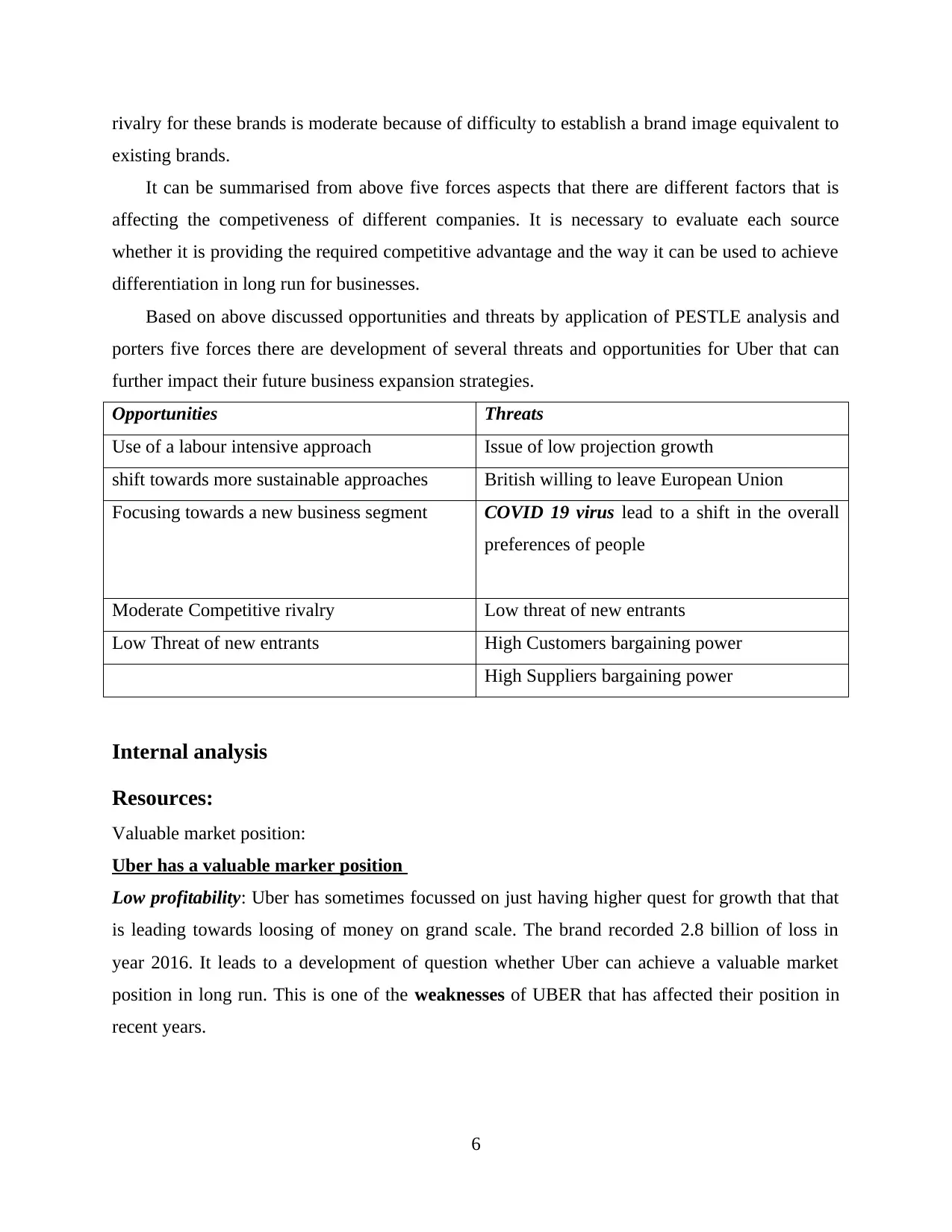
rivalry for these brands is moderate because of difficulty to establish a brand image equivalent to
existing brands.
It can be summarised from above five forces aspects that there are different factors that is
affecting the competiveness of different companies. It is necessary to evaluate each source
whether it is providing the required competitive advantage and the way it can be used to achieve
differentiation in long run for businesses.
Based on above discussed opportunities and threats by application of PESTLE analysis and
porters five forces there are development of several threats and opportunities for Uber that can
further impact their future business expansion strategies.
Opportunities Threats
Use of a labour intensive approach Issue of low projection growth
shift towards more sustainable approaches British willing to leave European Union
Focusing towards a new business segment COVID 19 virus lead to a shift in the overall
preferences of people
Moderate Competitive rivalry Low threat of new entrants
Low Threat of new entrants High Customers bargaining power
High Suppliers bargaining power
Internal analysis
Resources:
Valuable market position:
Uber has a valuable marker position
Low profitability: Uber has sometimes focussed on just having higher quest for growth that that
is leading towards loosing of money on grand scale. The brand recorded 2.8 billion of loss in
year 2016. It leads to a development of question whether Uber can achieve a valuable market
position in long run. This is one of the weaknesses of UBER that has affected their position in
recent years.
6
existing brands.
It can be summarised from above five forces aspects that there are different factors that is
affecting the competiveness of different companies. It is necessary to evaluate each source
whether it is providing the required competitive advantage and the way it can be used to achieve
differentiation in long run for businesses.
Based on above discussed opportunities and threats by application of PESTLE analysis and
porters five forces there are development of several threats and opportunities for Uber that can
further impact their future business expansion strategies.
Opportunities Threats
Use of a labour intensive approach Issue of low projection growth
shift towards more sustainable approaches British willing to leave European Union
Focusing towards a new business segment COVID 19 virus lead to a shift in the overall
preferences of people
Moderate Competitive rivalry Low threat of new entrants
Low Threat of new entrants High Customers bargaining power
High Suppliers bargaining power
Internal analysis
Resources:
Valuable market position:
Uber has a valuable marker position
Low profitability: Uber has sometimes focussed on just having higher quest for growth that that
is leading towards loosing of money on grand scale. The brand recorded 2.8 billion of loss in
year 2016. It leads to a development of question whether Uber can achieve a valuable market
position in long run. This is one of the weaknesses of UBER that has affected their position in
recent years.
6
⊘ This is a preview!⊘
Do you want full access?
Subscribe today to unlock all pages.

Trusted by 1+ million students worldwide
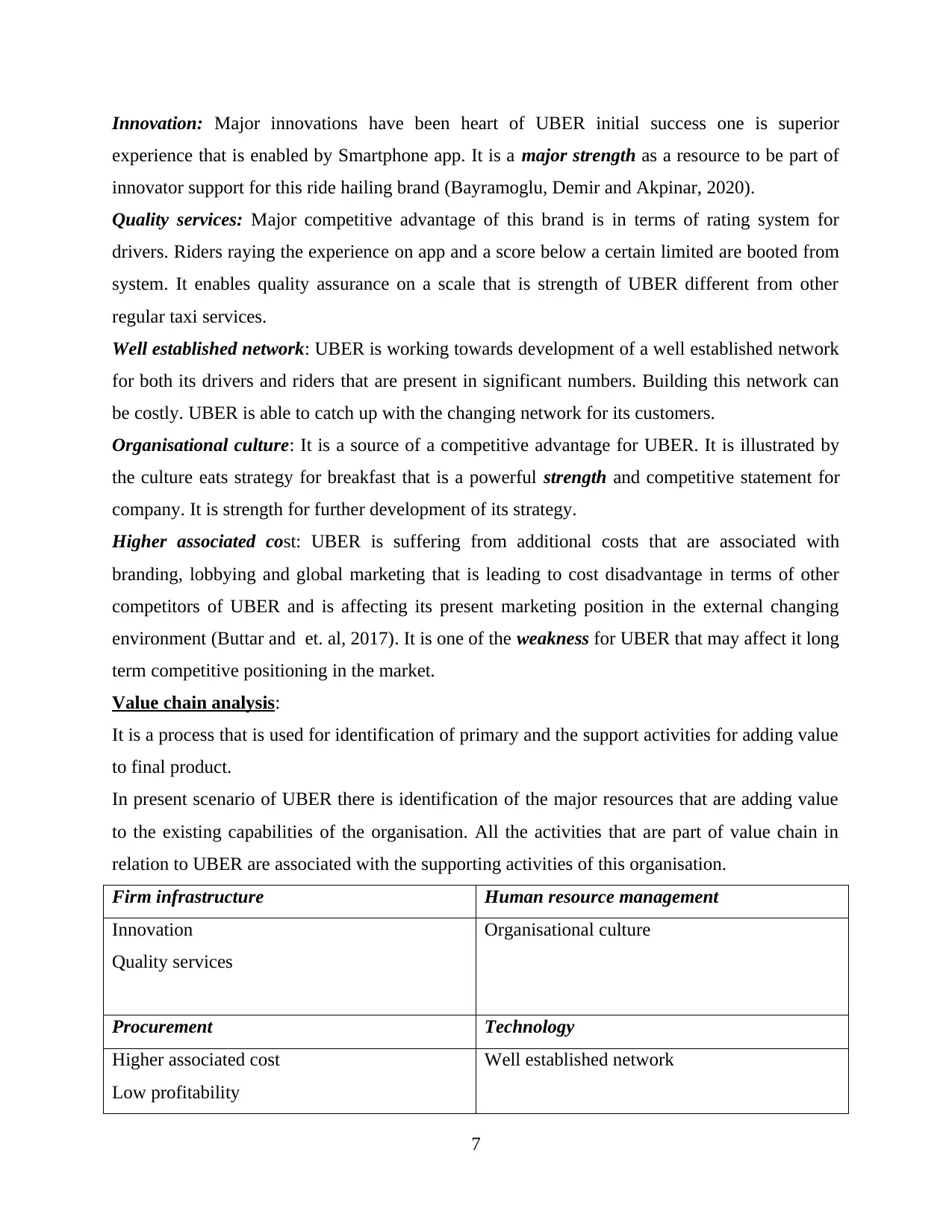
Innovation: Major innovations have been heart of UBER initial success one is superior
experience that is enabled by Smartphone app. It is a major strength as a resource to be part of
innovator support for this ride hailing brand (Bayramoglu, Demir and Akpinar, 2020).
Quality services: Major competitive advantage of this brand is in terms of rating system for
drivers. Riders raying the experience on app and a score below a certain limited are booted from
system. It enables quality assurance on a scale that is strength of UBER different from other
regular taxi services.
Well established network: UBER is working towards development of a well established network
for both its drivers and riders that are present in significant numbers. Building this network can
be costly. UBER is able to catch up with the changing network for its customers.
Organisational culture: It is a source of a competitive advantage for UBER. It is illustrated by
the culture eats strategy for breakfast that is a powerful strength and competitive statement for
company. It is strength for further development of its strategy.
Higher associated cost: UBER is suffering from additional costs that are associated with
branding, lobbying and global marketing that is leading to cost disadvantage in terms of other
competitors of UBER and is affecting its present marketing position in the external changing
environment (Buttar and et. al, 2017). It is one of the weakness for UBER that may affect it long
term competitive positioning in the market.
Value chain analysis:
It is a process that is used for identification of primary and the support activities for adding value
to final product.
In present scenario of UBER there is identification of the major resources that are adding value
to the existing capabilities of the organisation. All the activities that are part of value chain in
relation to UBER are associated with the supporting activities of this organisation.
Firm infrastructure Human resource management
Innovation
Quality services
Organisational culture
Procurement Technology
Higher associated cost
Low profitability
Well established network
7
experience that is enabled by Smartphone app. It is a major strength as a resource to be part of
innovator support for this ride hailing brand (Bayramoglu, Demir and Akpinar, 2020).
Quality services: Major competitive advantage of this brand is in terms of rating system for
drivers. Riders raying the experience on app and a score below a certain limited are booted from
system. It enables quality assurance on a scale that is strength of UBER different from other
regular taxi services.
Well established network: UBER is working towards development of a well established network
for both its drivers and riders that are present in significant numbers. Building this network can
be costly. UBER is able to catch up with the changing network for its customers.
Organisational culture: It is a source of a competitive advantage for UBER. It is illustrated by
the culture eats strategy for breakfast that is a powerful strength and competitive statement for
company. It is strength for further development of its strategy.
Higher associated cost: UBER is suffering from additional costs that are associated with
branding, lobbying and global marketing that is leading to cost disadvantage in terms of other
competitors of UBER and is affecting its present marketing position in the external changing
environment (Buttar and et. al, 2017). It is one of the weakness for UBER that may affect it long
term competitive positioning in the market.
Value chain analysis:
It is a process that is used for identification of primary and the support activities for adding value
to final product.
In present scenario of UBER there is identification of the major resources that are adding value
to the existing capabilities of the organisation. All the activities that are part of value chain in
relation to UBER are associated with the supporting activities of this organisation.
Firm infrastructure Human resource management
Innovation
Quality services
Organisational culture
Procurement Technology
Higher associated cost
Low profitability
Well established network
7
Paraphrase This Document
Need a fresh take? Get an instant paraphrase of this document with our AI Paraphraser
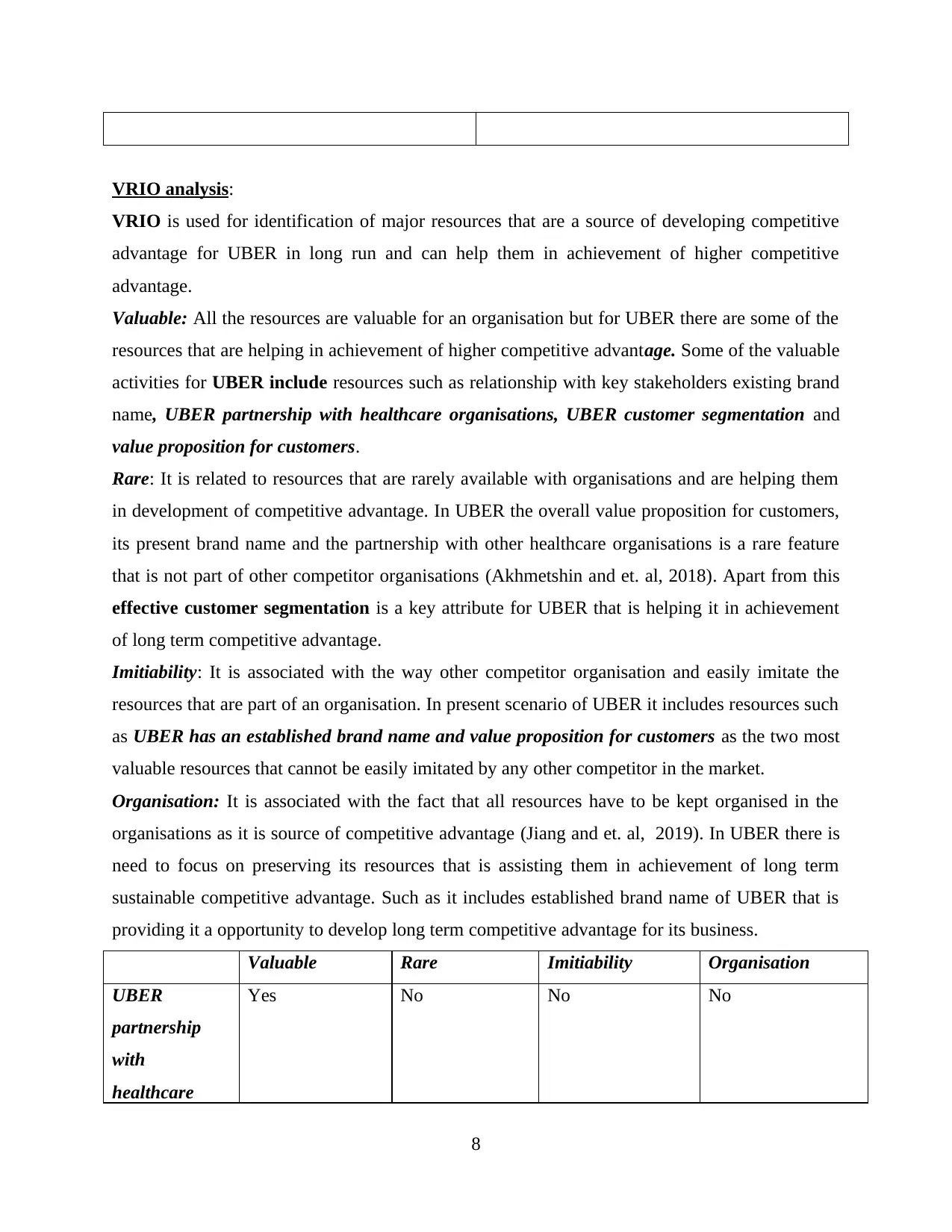
VRIO analysis:
VRIO is used for identification of major resources that are a source of developing competitive
advantage for UBER in long run and can help them in achievement of higher competitive
advantage.
Valuable: All the resources are valuable for an organisation but for UBER there are some of the
resources that are helping in achievement of higher competitive advantage. Some of the valuable
activities for UBER include resources such as relationship with key stakeholders existing brand
name, UBER partnership with healthcare organisations, UBER customer segmentation and
value proposition for customers.
Rare: It is related to resources that are rarely available with organisations and are helping them
in development of competitive advantage. In UBER the overall value proposition for customers,
its present brand name and the partnership with other healthcare organisations is a rare feature
that is not part of other competitor organisations (Akhmetshin and et. al, 2018). Apart from this
effective customer segmentation is a key attribute for UBER that is helping it in achievement
of long term competitive advantage.
Imitiability: It is associated with the way other competitor organisation and easily imitate the
resources that are part of an organisation. In present scenario of UBER it includes resources such
as UBER has an established brand name and value proposition for customers as the two most
valuable resources that cannot be easily imitated by any other competitor in the market.
Organisation: It is associated with the fact that all resources have to be kept organised in the
organisations as it is source of competitive advantage (Jiang and et. al, 2019). In UBER there is
need to focus on preserving its resources that is assisting them in achievement of long term
sustainable competitive advantage. Such as it includes established brand name of UBER that is
providing it a opportunity to develop long term competitive advantage for its business.
Valuable Rare Imitiability Organisation
UBER
partnership
with
healthcare
Yes No No No
8
VRIO is used for identification of major resources that are a source of developing competitive
advantage for UBER in long run and can help them in achievement of higher competitive
advantage.
Valuable: All the resources are valuable for an organisation but for UBER there are some of the
resources that are helping in achievement of higher competitive advantage. Some of the valuable
activities for UBER include resources such as relationship with key stakeholders existing brand
name, UBER partnership with healthcare organisations, UBER customer segmentation and
value proposition for customers.
Rare: It is related to resources that are rarely available with organisations and are helping them
in development of competitive advantage. In UBER the overall value proposition for customers,
its present brand name and the partnership with other healthcare organisations is a rare feature
that is not part of other competitor organisations (Akhmetshin and et. al, 2018). Apart from this
effective customer segmentation is a key attribute for UBER that is helping it in achievement
of long term competitive advantage.
Imitiability: It is associated with the way other competitor organisation and easily imitate the
resources that are part of an organisation. In present scenario of UBER it includes resources such
as UBER has an established brand name and value proposition for customers as the two most
valuable resources that cannot be easily imitated by any other competitor in the market.
Organisation: It is associated with the fact that all resources have to be kept organised in the
organisations as it is source of competitive advantage (Jiang and et. al, 2019). In UBER there is
need to focus on preserving its resources that is assisting them in achievement of long term
sustainable competitive advantage. Such as it includes established brand name of UBER that is
providing it a opportunity to develop long term competitive advantage for its business.
Valuable Rare Imitiability Organisation
UBER
partnership
with
healthcare
Yes No No No
8
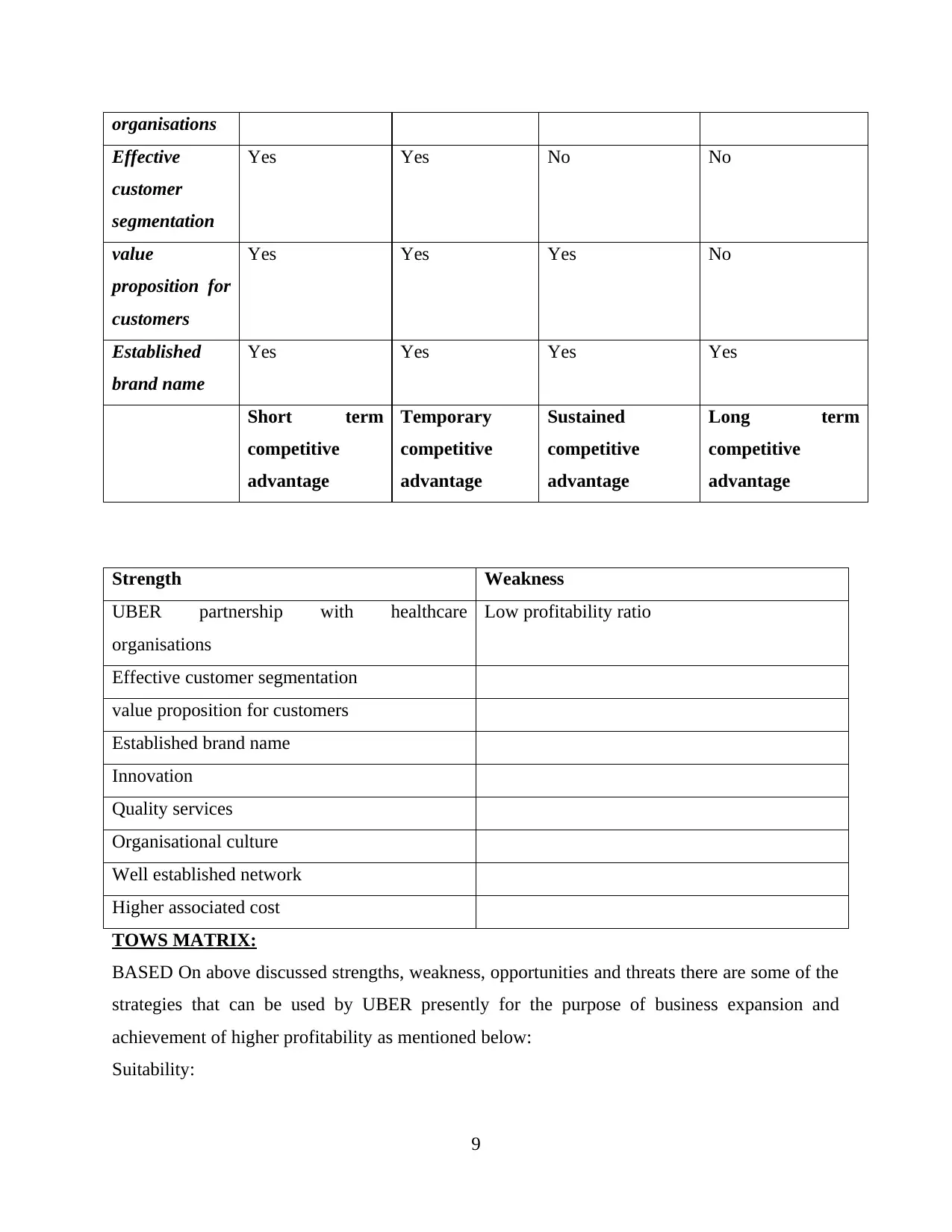
organisations
Effective
customer
segmentation
Yes Yes No No
value
proposition for
customers
Yes Yes Yes No
Established
brand name
Yes Yes Yes Yes
Short term
competitive
advantage
Temporary
competitive
advantage
Sustained
competitive
advantage
Long term
competitive
advantage
Strength Weakness
UBER partnership with healthcare
organisations
Low profitability ratio
Effective customer segmentation
value proposition for customers
Established brand name
Innovation
Quality services
Organisational culture
Well established network
Higher associated cost
TOWS MATRIX:
BASED On above discussed strengths, weakness, opportunities and threats there are some of the
strategies that can be used by UBER presently for the purpose of business expansion and
achievement of higher profitability as mentioned below:
Suitability:
9
Effective
customer
segmentation
Yes Yes No No
value
proposition for
customers
Yes Yes Yes No
Established
brand name
Yes Yes Yes Yes
Short term
competitive
advantage
Temporary
competitive
advantage
Sustained
competitive
advantage
Long term
competitive
advantage
Strength Weakness
UBER partnership with healthcare
organisations
Low profitability ratio
Effective customer segmentation
value proposition for customers
Established brand name
Innovation
Quality services
Organisational culture
Well established network
Higher associated cost
TOWS MATRIX:
BASED On above discussed strengths, weakness, opportunities and threats there are some of the
strategies that can be used by UBER presently for the purpose of business expansion and
achievement of higher profitability as mentioned below:
Suitability:
9
⊘ This is a preview!⊘
Do you want full access?
Subscribe today to unlock all pages.

Trusted by 1+ million students worldwide
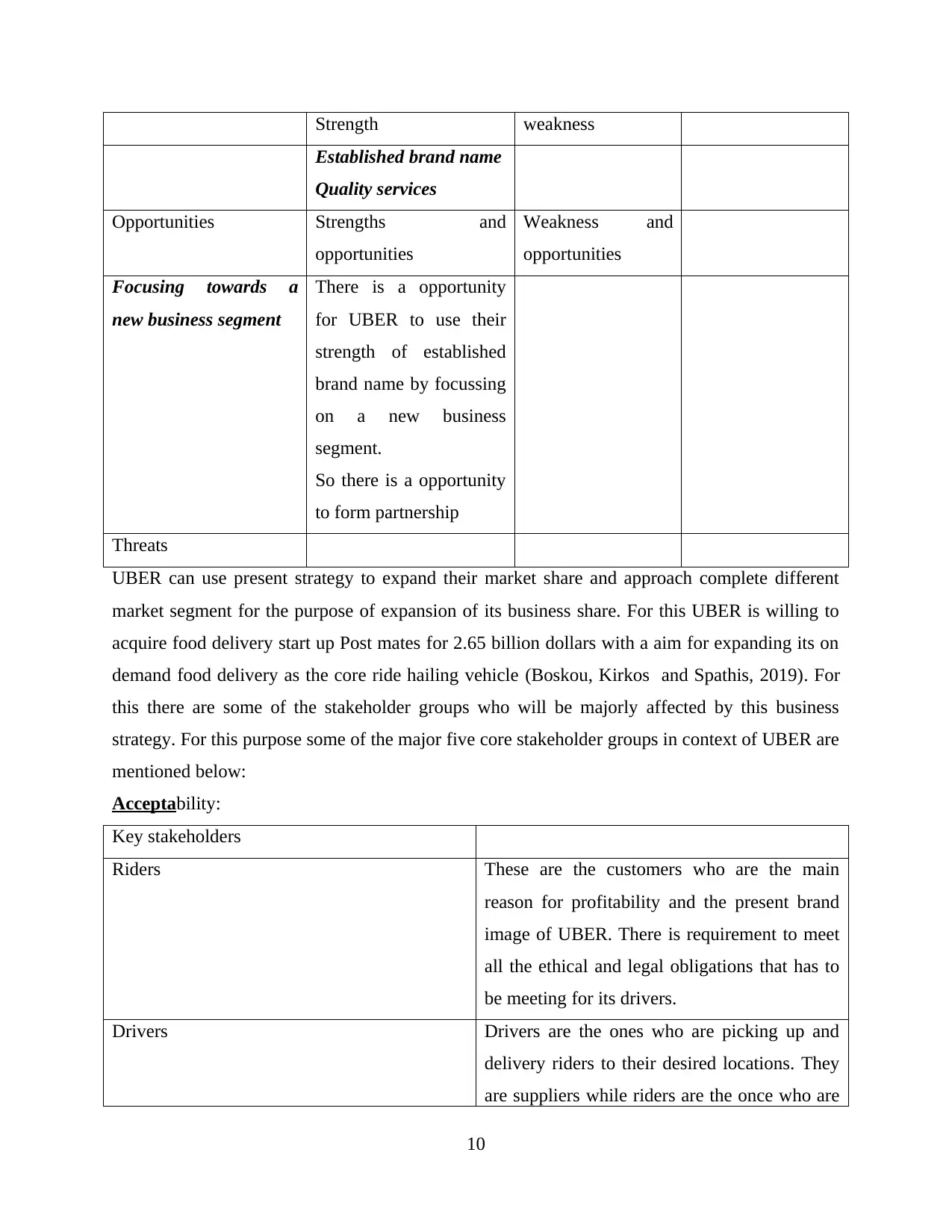
Strength weakness
Established brand name
Quality services
Opportunities Strengths and
opportunities
Weakness and
opportunities
Focusing towards a
new business segment
There is a opportunity
for UBER to use their
strength of established
brand name by focussing
on a new business
segment.
So there is a opportunity
to form partnership
Threats
UBER can use present strategy to expand their market share and approach complete different
market segment for the purpose of expansion of its business share. For this UBER is willing to
acquire food delivery start up Post mates for 2.65 billion dollars with a aim for expanding its on
demand food delivery as the core ride hailing vehicle (Boskou, Kirkos and Spathis, 2019). For
this there are some of the stakeholder groups who will be majorly affected by this business
strategy. For this purpose some of the major five core stakeholder groups in context of UBER are
mentioned below:
Acceptability:
Key stakeholders
Riders These are the customers who are the main
reason for profitability and the present brand
image of UBER. There is requirement to meet
all the ethical and legal obligations that has to
be meeting for its drivers.
Drivers Drivers are the ones who are picking up and
delivery riders to their desired locations. They
are suppliers while riders are the once who are
10
Established brand name
Quality services
Opportunities Strengths and
opportunities
Weakness and
opportunities
Focusing towards a
new business segment
There is a opportunity
for UBER to use their
strength of established
brand name by focussing
on a new business
segment.
So there is a opportunity
to form partnership
Threats
UBER can use present strategy to expand their market share and approach complete different
market segment for the purpose of expansion of its business share. For this UBER is willing to
acquire food delivery start up Post mates for 2.65 billion dollars with a aim for expanding its on
demand food delivery as the core ride hailing vehicle (Boskou, Kirkos and Spathis, 2019). For
this there are some of the stakeholder groups who will be majorly affected by this business
strategy. For this purpose some of the major five core stakeholder groups in context of UBER are
mentioned below:
Acceptability:
Key stakeholders
Riders These are the customers who are the main
reason for profitability and the present brand
image of UBER. There is requirement to meet
all the ethical and legal obligations that has to
be meeting for its drivers.
Drivers Drivers are the ones who are picking up and
delivery riders to their desired locations. They
are suppliers while riders are the once who are
10
Paraphrase This Document
Need a fresh take? Get an instant paraphrase of this document with our AI Paraphraser
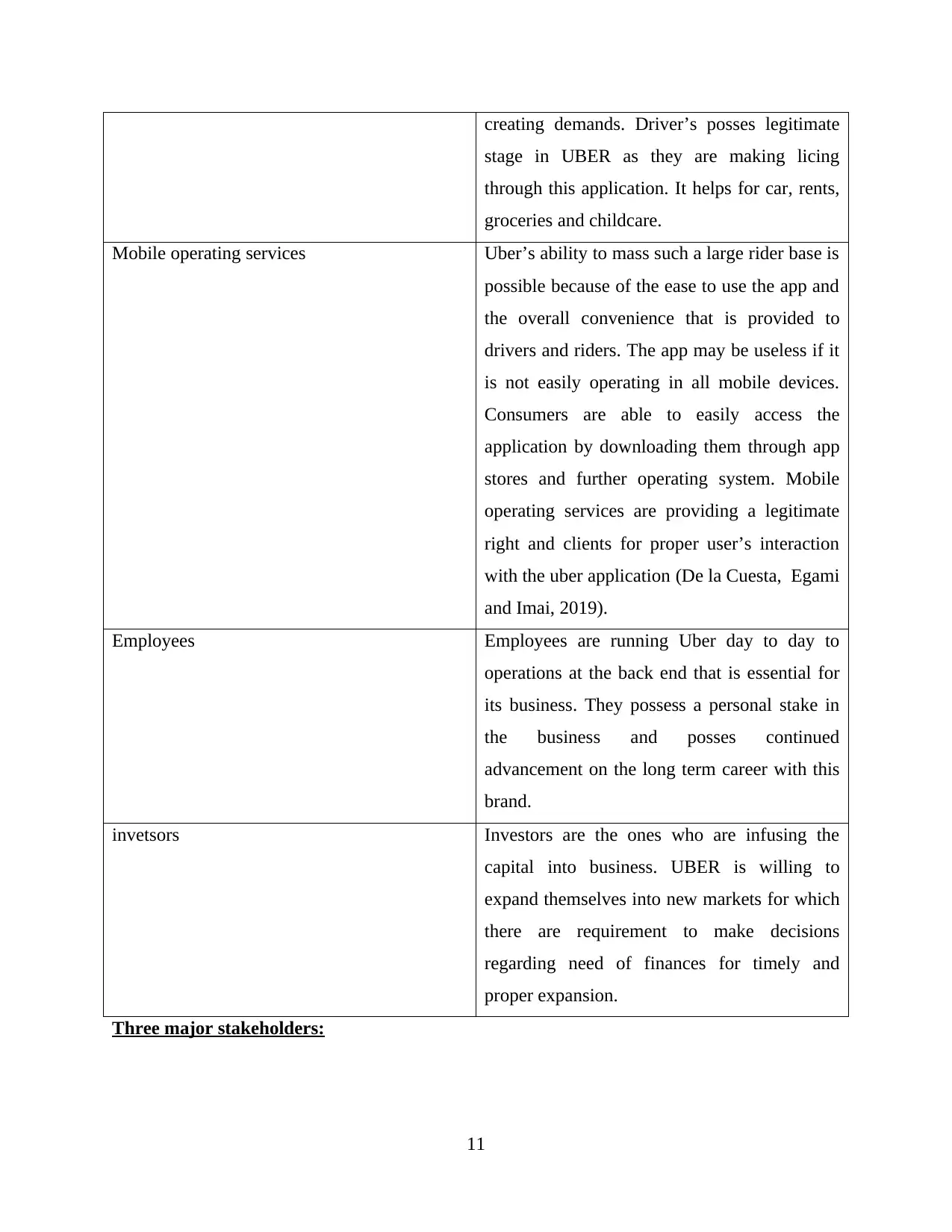
creating demands. Driver’s posses legitimate
stage in UBER as they are making licing
through this application. It helps for car, rents,
groceries and childcare.
Mobile operating services Uber’s ability to mass such a large rider base is
possible because of the ease to use the app and
the overall convenience that is provided to
drivers and riders. The app may be useless if it
is not easily operating in all mobile devices.
Consumers are able to easily access the
application by downloading them through app
stores and further operating system. Mobile
operating services are providing a legitimate
right and clients for proper user’s interaction
with the uber application (De la Cuesta, Egami
and Imai, 2019).
Employees Employees are running Uber day to day to
operations at the back end that is essential for
its business. They possess a personal stake in
the business and posses continued
advancement on the long term career with this
brand.
invetsors Investors are the ones who are infusing the
capital into business. UBER is willing to
expand themselves into new markets for which
there are requirement to make decisions
regarding need of finances for timely and
proper expansion.
Three major stakeholders:
11
stage in UBER as they are making licing
through this application. It helps for car, rents,
groceries and childcare.
Mobile operating services Uber’s ability to mass such a large rider base is
possible because of the ease to use the app and
the overall convenience that is provided to
drivers and riders. The app may be useless if it
is not easily operating in all mobile devices.
Consumers are able to easily access the
application by downloading them through app
stores and further operating system. Mobile
operating services are providing a legitimate
right and clients for proper user’s interaction
with the uber application (De la Cuesta, Egami
and Imai, 2019).
Employees Employees are running Uber day to day to
operations at the back end that is essential for
its business. They possess a personal stake in
the business and posses continued
advancement on the long term career with this
brand.
invetsors Investors are the ones who are infusing the
capital into business. UBER is willing to
expand themselves into new markets for which
there are requirement to make decisions
regarding need of finances for timely and
proper expansion.
Three major stakeholders:
11

The present strategy of UBER to acquire the food delivery start up post mates is a based on main
to expand their presence across o demand delivery. This is part of core ride hailing business. This
expansion wills posses a major impact on three main stakeholders that are mentioned below:
Customers: customers are the one of most important stakeholders in the present scenario
for UBER. With the changing external environment customers are looking for some
options of faster and quick food delivery. UBER is looking for growth as people stay
home in this pandemic because of the ride hailing business struggles the customers will
have a proper trust because of the established brand name of UBER in this scenario that
is going to help their customers in making right choices (Battaglia, Landoni and
Rizzitelli, 2017).
Employees: Employees who are performing daily activities of UBER will also affected
majorly because of this acquisition of food delivery start up by UBER. The brand has
announced an all stock deal for which employee support is very important in order to
achieve success similar as a ride hailing vehicle in this new business expansion (Gu and
Yang, 2019).
Mobile operating providers: Mobile operating providers will be providing an ease to use
the app and proper convenience for their customers. Mobile operating drivers will be
providing a proper platform for offering connectivity to drivers, restraints and customers
in recent years that will be fuelled by venture capital and armies of contract workers.
Feasibility: The present strategy of UBER to acquire post mates can be feasible for UBER
is based on requirement of new set of skills different from present workforce skills working
with UBER. Such as, it will need skills of food industry knowledge, effective marketing
campaigns and promotional skills. For this there is need to hire employees with such skill set
who can effectively contribute to. UBER has to analyse competitive strategies in this case
and based on that new hiring can be done by approaching competent employees through
employee exchanges. Further financial requirement can be fulfilled from existing base of
investors who can contribute towards success of UBER in proper business expansion (Uber
Buys Postmates for $2.65 Billion, 2020).
12
to expand their presence across o demand delivery. This is part of core ride hailing business. This
expansion wills posses a major impact on three main stakeholders that are mentioned below:
Customers: customers are the one of most important stakeholders in the present scenario
for UBER. With the changing external environment customers are looking for some
options of faster and quick food delivery. UBER is looking for growth as people stay
home in this pandemic because of the ride hailing business struggles the customers will
have a proper trust because of the established brand name of UBER in this scenario that
is going to help their customers in making right choices (Battaglia, Landoni and
Rizzitelli, 2017).
Employees: Employees who are performing daily activities of UBER will also affected
majorly because of this acquisition of food delivery start up by UBER. The brand has
announced an all stock deal for which employee support is very important in order to
achieve success similar as a ride hailing vehicle in this new business expansion (Gu and
Yang, 2019).
Mobile operating providers: Mobile operating providers will be providing an ease to use
the app and proper convenience for their customers. Mobile operating drivers will be
providing a proper platform for offering connectivity to drivers, restraints and customers
in recent years that will be fuelled by venture capital and armies of contract workers.
Feasibility: The present strategy of UBER to acquire post mates can be feasible for UBER
is based on requirement of new set of skills different from present workforce skills working
with UBER. Such as, it will need skills of food industry knowledge, effective marketing
campaigns and promotional skills. For this there is need to hire employees with such skill set
who can effectively contribute to. UBER has to analyse competitive strategies in this case
and based on that new hiring can be done by approaching competent employees through
employee exchanges. Further financial requirement can be fulfilled from existing base of
investors who can contribute towards success of UBER in proper business expansion (Uber
Buys Postmates for $2.65 Billion, 2020).
12
⊘ This is a preview!⊘
Do you want full access?
Subscribe today to unlock all pages.

Trusted by 1+ million students worldwide
1 out of 16
Related Documents
Your All-in-One AI-Powered Toolkit for Academic Success.
+13062052269
info@desklib.com
Available 24*7 on WhatsApp / Email
![[object Object]](/_next/static/media/star-bottom.7253800d.svg)
Unlock your academic potential
Copyright © 2020–2025 A2Z Services. All Rights Reserved. Developed and managed by ZUCOL.



